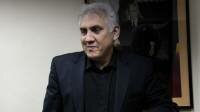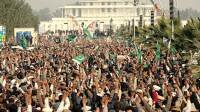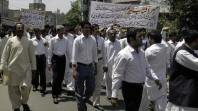Since it’s bad form to speak ill of the recently deceased, one resists the impulse to point out the sins that the late Jamaat-e-Islami Amir Qazi Hussein Ahmed has to atone for. But I will make an exception for one of them: the inflation of the million figure in public discourse. His million man marches, the term being borrowed from American Nation of Islam leader Louis Farrakhan’s attempt at the same, were never near that much.
I feel about numbers the same way as some writers feel about words. When they are blunted by overuse, perfectly good words have to be taken out of one’s arsenal even though they are quite perfect. As a result, attempts at effective writing end up in hyperbole.
Though the lakh, a mere tenth of a million, still retains some weight, the humble hazaar is now scoffed at. As anyone who has attempted to gather even twenty people into a political rally of their own free will can attest, this is difficult business and a thousand people is, in fact, a huge crowd. But sustained hyperbole has shunted it to the province of corner meetings.
The problem with a million is that it has six, count them, six, zeros. Instead of getting four million, which Dr. Tahir-ul-Qadri claimed he would, he got less than a hundredth of that size. Did that matter, though? He had women and kids in his crowd of 30,000 (we’ll get to that in a while) and that afforded him some leverage. Perhaps more leverage than, say, a JUI-F rally, mammoth in its own right, has.
Then there was Qadri’s colorful past. With reports of a documented schizophrenia doing the rounds, coupled with a demonstrable lack of concern for the wellbeing of his flock, when Qadri warned of a “final action” on the last day of the sit-in, there was a feeling that he would ask for the women and children to raid the parliament building. Despite the oft-touted comparative difference with the Musharraf regime, the soft PPP administration would have necessarily had to stop this by force, resulting, inadvertently, in scores of injuries and at least some deaths. So, regardless of the scale of the crowd, it was a potentially dangerous one.
Therefore, the specific numbers weren’t the centre of the debate. Nor were they at the centre of the government spindoctors’ protests.
But the specifics are, in fact, the centre of the public’s fascination. So much so that there were many public sparring sessions on the figure alone.
Even prior to the event, rally sizes had been the subject of much debate. The size of the PTI’s huge rally in Lahore was the subject of heated debate. So were the rallies staged by the PML-N in response.
News organisations the world over use the Jacobson Method for estimating crowds. Named after journalism professor Herbert Jacobs who came up with it, the method simply divides any venue into different sections, then averages out the number of people in each section and finally multiplying that figure with the number of sections. He worked out that a “light” crowd would have a density of one person per every ten square feet whereas a “dense” crowd would be one person for every 4.5 square feet.
You don’t need a degree in statistics to know this method isn’t too precise. And not just within acceptable limits. Crowds are not neat constructs. They don’t have one single, uniform density. In fact, their densities vary so much that even averaging them out doesn’t do the trick.
For this, companies that specialise (yes, specialise) in counting crowds take aerial photographs, divide the area into a grid, identify the densities of the various blocks therein multiply with the appropriate numbers. Some pattern recognition algorithms, not without their flaws, are used to detect human heads.
For this, satellite imagery, helicopter and hot air balloon shots are used. This is the method that Digital Design and Imaging Service, an American company, used (see image) to estimate the size of the rally of Glenn Beck, a former Fox News conservative pundit.
In Pakistan, however, the news media doesn’t even use the simpler Jacobson method. In fact, not many relevant images are captured to begin with. In light of such circumstances, the exercise can be “crowdsourced.” Statisticians are fond of recounting the anecdote where Sir Francis Galton, the 19th century polymath was surprised that, at a cattle fair, the average of the laymen estimates of the weight of a particular ox was far closer to the actual weight than the individual figures given by cattle experts.
The age of the internet makes crowdsourcing a far more easier exercise than it used to be. A number of respondents can be asked, for instance, to count the number of people in a particular square in a grid and those results could be averaged out. Universities invested in the idea of crowdsourcing have their students do such exercises. Other enterprises, like Amazon’s Mechanical Turk project hooks “requesters” with dispersed crowds of humans who do the estimates for free. The trick is to disregard the drastic outliers and average out the rest.
For the Tahir-ul-Qadri rally, unfortunately, there weren’t many people who did provide a studied estimate of the crowd size, at least not the bare minimum for what statisticians call the “normal distribution” to hold true.
For what it is worth, there were multiple sources. There was the interior minister Rehman Malik’s estimate. Then there was the Islamabad police’s estimate. Then there was the district administration’s estimate. Then there were the figures given by some of the intelligence agencies, the several estimates given by independents and lastly, the figure given by the Minhaj-ul-Quran itself.
The interior minister’s figure, susceptible, obviously, to political posturing, was 15-20,000 people. Officials within capital city police estimated around 30,000. Independent estimates quoted the same figure. Certain intelligence agencies were quoted at 80,000, a clear outlier. But the MQI, for obvious reasons, took the cake and went with one million.
The most informed estimate would presumably be the one given by the Islamabad civil administration, which was tasked with looking at, and arranging for, each and every aspect of the assembly. The administration gave a figure of 30,000 at the peak time. Dissipation towards the end almost halved the figure.
Mahatma Gandhi used to travel in economy class railways, making his safety a great deal more problematic than if he were travelling first class. This required a larger security detail. This state of affairs prompted Congress leader Sarojani Naidu to quip that it took a fortune to keep Gandhi poor.
Well, it did take a fortune to keep the Allama....safely ensconced in the cozy comfort of his heated container. The federal government spent an estimated Rs5 crore for the couple of days of the sit-in.
The ICT Police’ strength was inadequate. In addition to the 5,000 capital city policemen that are available in a given shift, the administration had to request for back-up. The Punjab Police provided 8,000 personnel. The Azad Jammu and Kashmir Police provided 2,500 policemen. The Rangers deployed 3,000 of their own while the Frontier Constabulary provided an additional 2,000 jawaans.
Then there were the medical camps that had to be set up for the participants of the rally, the extra medical and para-medical staff that had to be at the city’s hospitals to care for the ill.
Both the Islamabad administration and the police did a commendable, yet thankless job. Managing such high figures were made possible by the right attitude. “This is not a war,” says Islamabad DCO Amer Ali Ahmed. “A lawful and peaceful protest has to be facilitated.”
In the absence of precise estimates, the press in Pakistan has to sometimes rely on the ordinal scale. Tahir-ul-Qadri’s rally at Minar-e-Pakistan was larger than the PTI’s at the same venue. And they were smaller, we are told, than BB’s spectacular rally there in ‘86. The ordinal scale is woefully inexact, but at least it is correct.
In the final analysis, it has to be pointed out that more democracy leads to, counterintuitively, lesser political rallies. When party machinery, the framework of the state and public interest groups at large are well integrated, there should be no need for such large rallies. A couple of democratic terms later, even the political parties will find that corner meetings are the where-its-at of electoral politics.
The writer is the Executive Editor.





















